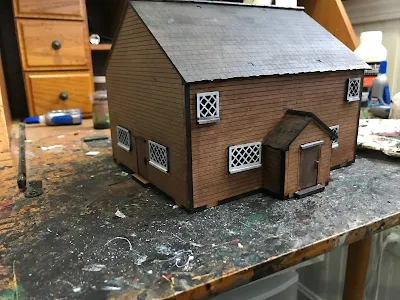In addition to the Salem Meeting House Things from the Basement has also released two New England style houses. These can be built as is, or you can add the extension kits to make them into the traditional salt box style homes. I have chosen to add the extension as I really like that style and worked inside that type of house during my career with the park service. Both houses are alike so I will just describe building one of them to give you an idea of how they go together. A second post will go into how to paint these period houses and how I painted them.
First off I lay out the parts sheet to familiarize myself with them. After downloading the assembly plans from the site I am ready to start putting these together. I use superglue to assembly the building. I then usually add a beading of white glue along the inside edges for added strength.
One of the nice details is the windows of these buildings. There are two parts and you snap out the windows and ledge you want. I tend to do these all at one, assembly line fashion. Glue the window to the ledge and then push it through into the opening. These give a nice effect and each has great details.
Also note there are two doors for each building. One fancy, which I will use for the front and the others plain which I will use for the back.
Next step is glue the four walks to the floor. Again take A moment to fit the pieces together before you glue them. You may want to secure them with a rubber band as they dry. There is a second floor to the building which you can just drop in. This is for skirmish type gaming. I glue the floor for added strength as I do not bother putting figures into the buildings. I also glue down the roof but you do not have to.
Lay out the chimney assembly. I suggest carefully fitting it together before gluing. Its a little fidgety so take your time. Same with adjusting the roof around it. Make sure the glue is dry on the chimney and take your time fitting it together. When done fit to the house. You can glue it to the house or not to fit your games.
Lastly, once together I assembled the extension. No need to go into the details. It fits to the main house easily. once done you have a great little house put together to grace your table top terrain. Well, actually two houses with this kit!
Next time I will go into a little about historical home colors in New England in the 17th and 18th century as well as how I have painted these homes. See you then!
Hey! Get your chickens off my lawn!
Update:
The second one house you get in the package us slightly different then the one I built here. So you get two of the same house types but both are slightly different. More value for the money. Well done!


















































